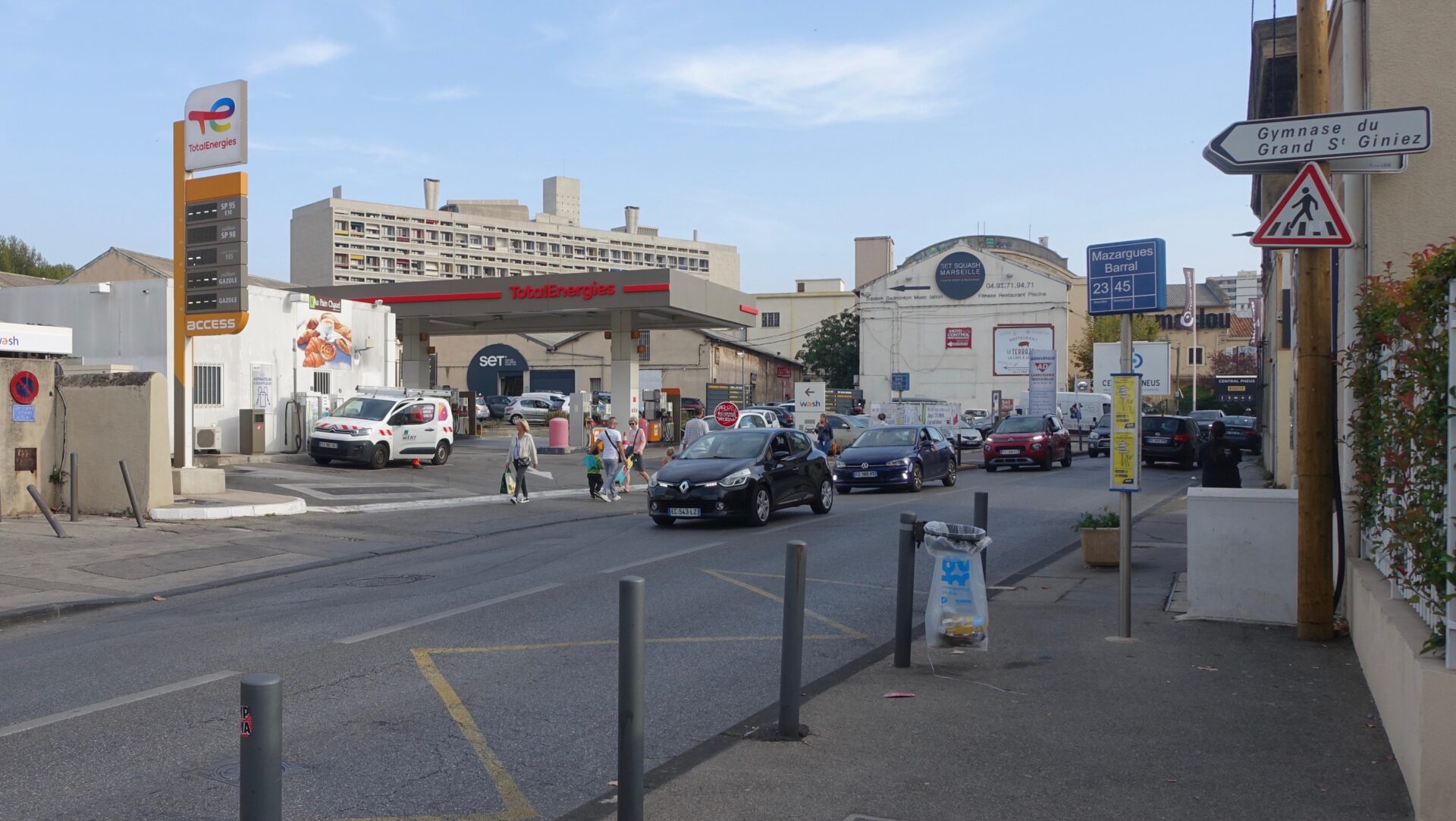
“It’s Not a Monument Just Standing There in All its Monumentality”
Thomas Meinecke (TM) in Conversation with Julian Müller (GAM)Thomas Meinecke is an author, musician, and DJ. While studying theater and modern German literature in Munich, he founded the literary magazine Mode und Verzweiflung, from which the band F.S.K. (Freiwillige Selbstkontrolle) originated. Since 1986 he has published numerous stories, audio plays, and novels, including Tomboy (1998), Lookalikes (2011), and Selbst (2016), and he has won several literature prizes. In 2022, Thomas Meinecke moved to Marseille and has been living in one of the 337 apartments in the Unité d’Habitation designed by Le Corbusier from 1945 to 1952. Julian Müller spoke with him about everyday life in this historically relevant housing complex.
GAM: We recently met at an event, and during the coffee break you told me that you had just moved to Marseille and have been living in the Unité d’Habitation. First of all, please tell me how you ended up there …
TM: I saw the building for the first time when I was on a bicycle tour of France with my wife, Michaela Melián. We were careening down the hill into the city from the Calanques range and suddenly saw, out of the blue, this building through the trees, this architecture, which was of course quite familiar because it has become so deeply inscribed in the collective consciousness. We were not at leisure to stop that day, for we were short on time, with quite a distance still to go. In any case, that was my first encounter with the building, which until then I had only seen in photographs. And then, about fifteen years ago, I stood on the roof of the structure for the first time. Friends of ours were living there, which is how we were able to enter the building. We were utterly fascinated by this roof; it really captivated us. We were standing up there with tears in our eyes. It felt like something was being said about a better world, about a world that would never come. Arising from this discrepancy between what one sees and what does not actually come to pass was a feeling similar to what we sometimes experience when listening to music with its nonverbal, visionary power. And from that moment on, it was our dream house.
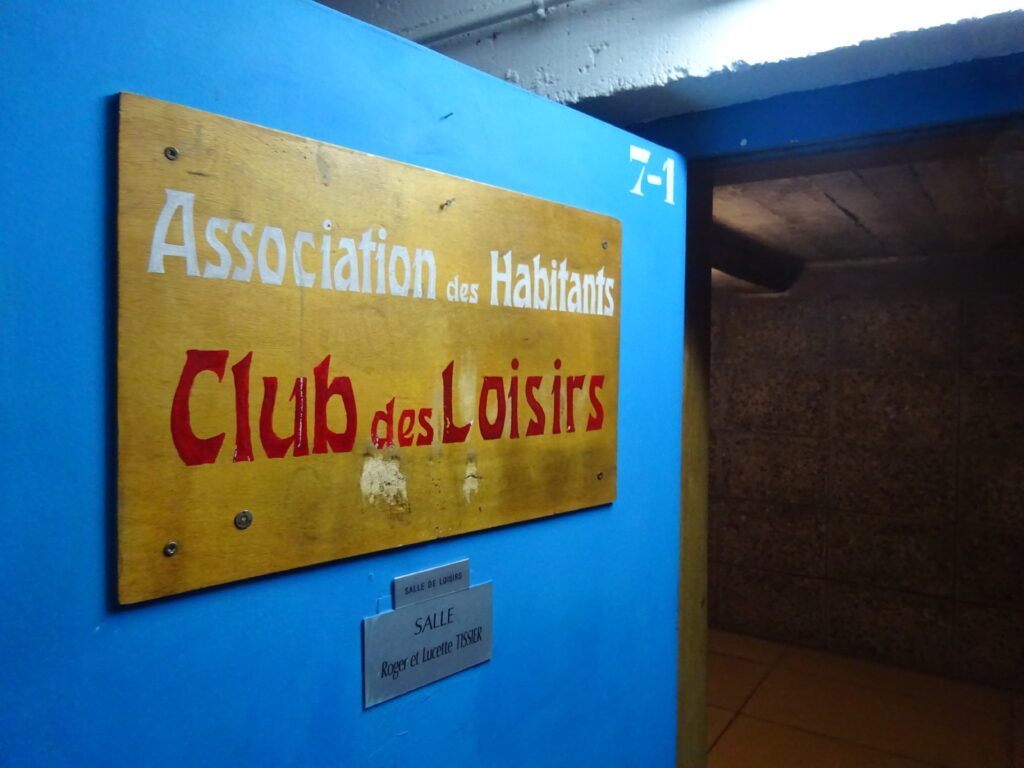
GAM: How did you go from being smitten visitors standing on the roof to residents of the building?
TM: My father passed away a while back, which is why I sold my parents’ house. Interestingly enough, in my family home there was a certain affinity with that which the Unité d’Habitation symbolizes. My parents had been proponents of a very Frenchified modernity. They enjoyed listening to French pop music and modern jazz, we spent our summer vacations on the French Riviera, my father drove a Citroën DS, and we had a Corbusier armchair in our living room. So when I sold my parents’ home, smack-dab in the middle of the pandemic, I suddenly had money. And since I’m not the type of person who likes to throw money around the markets, my wife and I gave some consideration to where else we might like to live. We have been residing in a village with about 100 inhabitants in Upper Bavaria, and while it is very beautiful, there are of course no urban qualities. So we went through various cities in our heads: Naples was one, Barcelona too, and then Marseille.
GAM: But how did you manage to get an apartment in the Unité d’Habitation? Is that not just incredibly difficult?
TM: It really was a stroke of luck. Most of the free apartments never make it to the real-estate market because they are passed along by word of mouth within the community itself. The people living there truly adore the building, and some families have even been there for three generations. In any case, the previous owner had taken over the apartment directly in-house and then carried out extensive renovations—though not always purely according to the provisions associated with Le Corbusier. For example, the previous owner modified the kitchen. It’s important to understand that these kitchens really are very small. It almost feels claustrophobic. Reading Le Corbusier’s words on the subject, one notices that in his mind “the woman” should only have to turn around once in a circle in order to be able to reach everything in the kitchen. But a woman was also more or less trapped in the kitchen—there is no gentle way to put it. At any rate, it appears that the wife of the previous owner had a black stone kitchen installed—from Stuttgart, by the way—that does not quite fit with our personal tastes. Legend has it that she still didn’t want to live in the apartment, even with this kitchen of her choice. Since it apparently embarrassed the new owner that he and his wife could not in fact move in after this extensive renovation work, the apartment was not passed along in-house like usual but rather ended up on the free market. And on the very day the ad went online, I was sitting in front of my computer once again looking for apartments in this building. The whole thing was a giant coincidence. We didn’t even travel there to view the apartment—for it was of course at the height of the Covid-19 pandemic—but instead purchased it solely based on a WhatsApp tour. And we have been living there ever since. Occasionally someone in the elevator will ask me how we ended up here, that is, how it happened that two Germans succeeded in getting an apartment.

GAM: You mentioned having been familiar with the Unité d’Habitation before you were there for the first time. It is, as you noted earlier, part of our collective consciousness. In your novels, you thematically explore the iconic again and again, especially icons of pop culture. Do you see this building as an icon?
TM: Yes, we do see the building as an icon. Every single day one is amazed at the holes and air vents in the walls. And one wonders where the air is actually coming from and why we never hear the neighbors. Serving as inspiration for Le Corbusier’s building principle in designing the Unité d’Habitation was, in fact, a bottle rack. Indeed, the building is almost like a shelf made of concrete, into which apartments made of wood were inserted. This sets the Unité d’Habitation in Marseille apart from its counterpart in Berlin. So all day long you are treading on creaking wooden floorboards, and the windows are all made of wood, with very old fittings. There is a rather archaic village blacksmith feel to the whole building. You never stop noticing such things, including the way the light falls. One is constantly examining the building as to how it was made, and wondering what he—Le Corbusier—might have been thinking. To a certain extent, one is living in a conceptual model. In Marseille, the building is also called “La maison du fada,” which means “house of the madman.” Of course, this was meant as an insult, but the building really does spawn many highly irrational moments. Yet this has little to do with a rather simplistic concept of rationalism. Rather, the house is soulful, especially up on the roof. And in terms of a programmatic approach, it is strongly geared toward children. For example, the railings are mounted at calf height, making them totally unsuitable for adults. And the stairs have a groove in the middle of the step area to allow toddlers to grab on and pull themselves up. Such details are found all over the building. The most prominent space on the rooftop is the kindergarten crafts room. You see crazy things there daily when the children are running around this concrete landscape. There must be a knee needing a Band-Aid every single day.
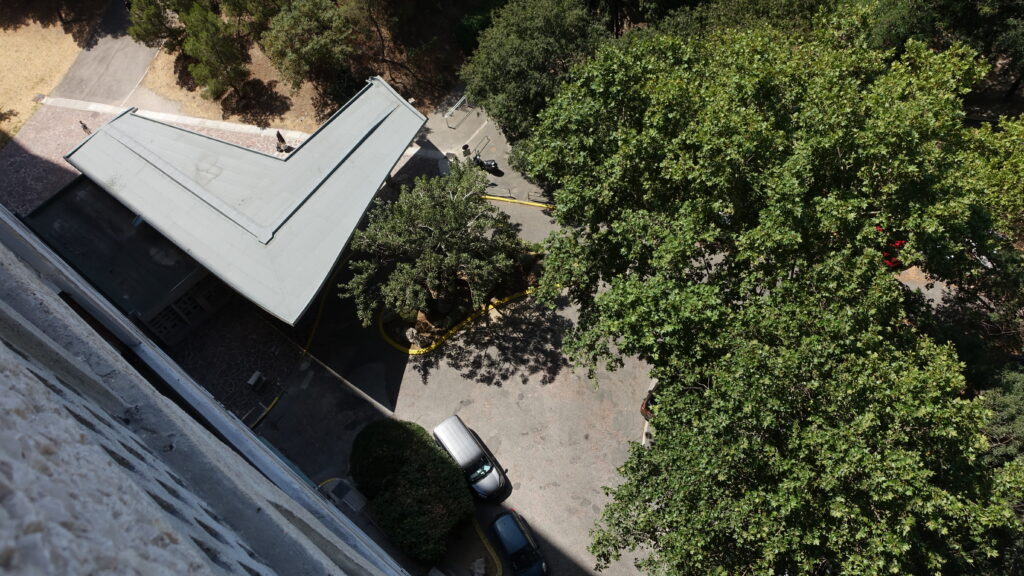
GAM: Le Corbusier had a very clear idea of how to tailor his design to day-to-day family life in the building. He integrated everyday processes into the planning process, for instance through the corresponding common areas, the kindergarten, the shopping street, and much more. What is everyday life really like at the Unité d’Habitation today?
TM: The shopping passageways still exist, but today they are used in a very different way than originally planned. The hotel, for example, which is located within the building, originally served as dwellings for guests visiting the residents. This is because the apartments themselves hardly have room enough for welcoming overnight guests. Since there are not many doors, space for being alone in the units is rather limited. That’s why these guest apartments were in use until about 1965. Then there is an art space where mostly exhibitions about architecture are shown. There actually used to be washing machines located in this room. Then there was a supermarket, which is even still discernible from the outside, because the lettering remains slightly legible. Today, sometimes exhibitions are shown in this space. As a matter of fact, the stores are not vacant; they’re simply used in a different way. Then there is the former gym on the roof, which the French designer Ito Morabito has snapped up, though he only uses it occasionally, so many of the residents are angry with him. Anyways, there are hardly any traditional stores left. Though there is still a small pâtisserie, also serving as a café. And of course there is the big restaurant, which is very popular, not least because you can sit on the balcony with a view of the sea. And there are a few hip stores—I had really expected worse—and several architectural firms. Moreover, there is a chiropractor and a bookstore, the latter being primarily concentrated on architecture and quite well visited. Alongside the bookstore is a merchandising shop, where items are even sold that are only remotely connected to the building and to Le Corbusier. And let’s not forget to say that lots of visitors stop by every day, many of whom are specialists, such as art historians or architects.
GAM: So it is a building that is constantly reflecting on itself in one way or another. It sounds as if one cannot help but think of it as an attraction. Or does that effect eventually wear off?
TM: One could get around it if one really wanted. The building also has apartments for students directly facing the loud boulevard without any view of the sea. I would guess that these residents don’t see the building as a never-ending attraction. There is the Association des habitants, founded soon after the building was inaugurated. Members pay an annual fee, allowing one to use a few hidden things in the building that are not really considered attractions. For instance, near the stairwells there are a few incognito rooms, like in the film Being John Malkovich. There is a small library run by a touching elderly gentleman who is tasked every month with acquiring six or seven new relevant publications. You’ll find the new book by Annie Ernaux there, or one by Didier Eribon, as well as lots of children’s books. And if you ask when the book you’ve chosen needs to be returned, he replies, “Well, when you have finished reading it.” It’s fantastic how anachronistic everything is. There is also a little cinema showing films by Akira Kurosawa or Werner Herzog. There are thirty or forty cinema seats set in a hidden, rather plain room. In the Jardin d’hiver, the wintergarden, you’ll also find a gathering place. It really is all very touching. Occasionally meetings will be held there, attended by a few legendary people who grew up in the building. And when we also attend, sometimes we hear dumbfounded questions like: “Who are you? And what are you doing here?” So there is certainly a vibrant social life going on for everyone living in the building. But of course there are also Airbnbs, and there is an apartment that is not rented out but is instead reserved for shooting films, because everything inside is still original.
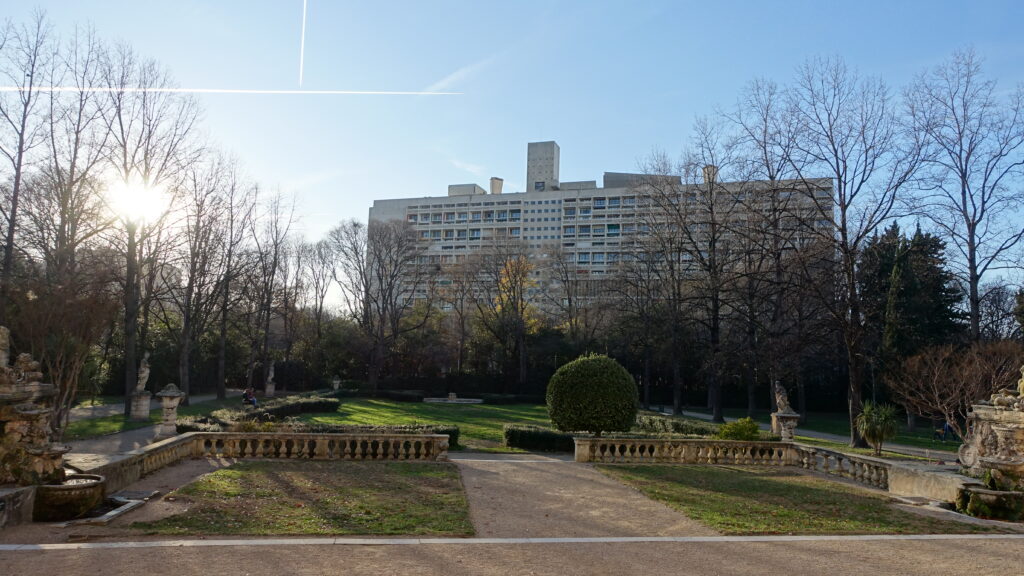
GAM: Please describe to me how the Unité d’Habitation is actually situated in the city. Shouldn’t we be imagining the building as Le Corbusier did, like a giant ocean liner stranded in the urban realm?
TM: The building is standing on stilts, of course, surrounded by greenery. It is located in the former park of a small castle from the seventeenth century. So we look down on this little castle. In the nineteenth century, the park was already divided by a wide boulevard, as straight as if drawn by a ruler, which today also runs past the Olympique de Marseille stadium. When soccer games are played there, the clouds of smoke from the Bengal lights reach us here, and you can basically hear every single foul. The neighborhood is rather unique in general. Officially, the building is located within an industrial area, a zone industrielle. Surrounding the structure are lots of automotive repair shops and former industrial premises, but also quite a few high-rises which, amusingly enough, have balconies facing the Unité d’Habitation. So the building does appear to be a compelling urban landmark. And yes, it really is kind of an ocean liner that is stranded there. At the same time, in contrast to many of the surrounding buildings, it is not locked up at all. In the near vicinity there are numerous gated communities. If I want to go to the beach, which is only about a kilometer away, then I have to walk at least two kilometers because of the detour around these gated communities. So for this reason it is a pleasantly mixed area: the soccer fans park along the boulevard in front of the building, two prostitutes on wheels come park under the building, and people from the area let their dogs make a mess in the park. But all this is somehow very likeable, especially because it’s not a monument just standing there in all its monumentality. That wouldn’t be possible anyway, since nearly 1,000 people are living there.
GAM: You had a text published in a 1981 issue of Mode & Verzweiflung, a passage which reads: “We enjoy thinking back on those balmy summer evenings when we sat on our 13th floor balcony, letting our gaze wander to the green outskirts of the city. We had always liked the high-rise buildings.”
TM: Back then, that was of course written in an ideological battle against such hippie ideas …
GAM: … and one of the most famous lyrics from your band F.S.K. reads, “And we say Yes to the modern world.” The Unité d’Habitation itself represented a very loud architectural “Yes” to the modern world. Yet at the same time, this modern architectural world of the time is today a bygone one. What is it like for you, as a decidedly unnostalgic author, to live in a utopia that has already become obsolete?
TM: True, it really is a bittersweet feeling. Sometimes an old Citroën DS will be standing in front of the building, and it evokes such a feeling of nostalgia about how the future, as it was laid out back then, somehow never came to pass. But does this building nonetheless remain a strong philosophical statement? You know, I like to read Peter Kropotkin or Gustav Landauer. And though things didn’t turn out as planned, you still might feel inspired in certain circumstances—even if anarchy certainly never did play out. In fact, a kind of halo hovers above these ideas. But you are so right. Now my father’s Corbusier armchair is situated in the apartment, which is somehow a museum of sorts for the progressive ideas of the past. However, it is not this way all over the building. From time to time, the residents show each other their apartments in turn, often with a tinge of pride. So one occasionally finds oneself standing in an apartment that no longer recalls Le Corbusier, for instance because it is filled with Biedermeier furnishings.
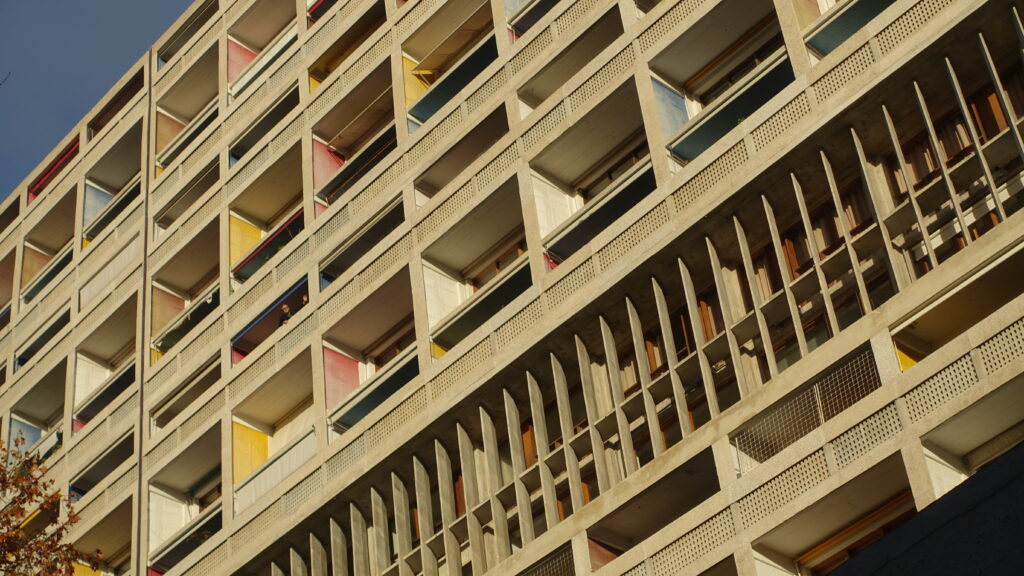
GAM: I would like to close by asking what role architecture plays for you as an author. I have the feeling that concrete rooms and places had a much stronger presence in your earlier texts—this is made clear by titles like Café Adler, Interieur, or Villa Hammerschmidt. It appears to me that, over time, this interest in places and spaces has been replaced by an interest in fashion, gender roles, theory, and language. Do you share this assessment, or am I barking up the wrong tree?
TM: I think you’re mistaken here. In my upcoming novel, for example, a very concrete site plays a pivotal role. The book deals with Amorbach, as one of Theodor W. Adorno’s places of longing. And in Amorbach there are a number of buildings designed by Peter Speeth, one of the few German representatives of revolutionary architecture. And from there, in the novel, I end up in Odessa, where Speeth had also designed buildings. Another of my novels, Hellblau, which is set in Chicago, has architecture as one of its main motifs. This is because the social housing estates on Chicago’s South Side were demolished around the time I was writing the novel. That represented an utter capitulation of the ideas and hopes associated with the building of these high-rises. So I actually would say that, for me as an author, architecture is a very essential plane of reference that enables me to tell a story.
GAM: Thank you for the conversation.
Translation: Dawn Michelle d’Atri